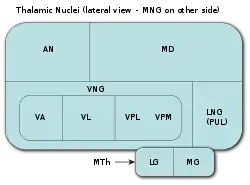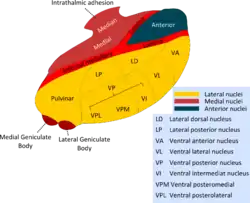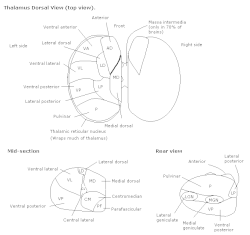Ventral posterior nucleus
The ventral posterior nucleus is the somato-sensory relay nucleus in thalamus of the brain.[1]
| Ventral posterior nucleus | |
|---|---|
 Thalamic nuclei: MNG = Midline nuclear group AN = Anterior nuclear group MD = Medial dorsal nucleus VNG = Ventral nuclear group VA = Ventral anterior nucleus VL = Ventral lateral nucleus VPL = Ventral posterolateral nucleus VPM = Ventral posteromedial nucleus LNG = Lateral nuclear group PUL = Pulvinar MTh = Metathalamus LG = Lateral geniculate nucleus MG = Medial geniculate nucleus | |
 Thalamic nuclei | |
| Details | |
| Part of | Thalamus |
| Identifiers | |
| Latin | Nucleus ventralis posterior thalami |
| NeuroNames | 343 |
| NeuroLex ID | birnlex_1116 |
| Anatomical terms of neuroanatomy | |
Input and output
The ventral posterior nucleus receives neuronal input from the medial lemniscus, spinothalamic tracts, and trigeminothalamic tract. It projects to the somatosensory cortex and the ascending reticuloactivation system.
Subdivisions
The ventral posterior nucleus is divided into:
- Ventral posterolateral nucleus, which receives sensory information from the body via the medial lemniscus, and spinothalamic tracts.
- Ventral posteromedial nucleus, which receives sensory information from the head and face via the trigeminal nerve.
- Ventral intermediate nucleus, implicated in oscillatory tremor generation in Parkinson's disease and essential tremor.[2]
Function
The ventral posterior nucleus has, by virtue of its afferent and efferent pathways, crucial relay and regulatory roles in touch, body position, pain, temperature, itch, taste, and arousal. Additionally, the VPN—and particularly the ventral intermediate nucleus of the VPN—have been implicated in the pathophysiology and modulation of oscillatory tremors as found in Parkinson's disease and essential tremor; accordingly, it is a target of deep brain stimulation in the treatment of such pathologies.
Additional images
 Thalamus
Thalamus Thalamus
Thalamus
References
- Sheridan, Nicholas; Tadi, Prasanna (2023), "Neuroanatomy, Thalamic Nuclei", StatPearls, Treasure Island (FL): StatPearls Publishing, PMID 31751098, retrieved 2023-09-17
- Deiber, MP (1993). "Thalamic stimulation and suppression of parkinsonian tremor". Brain. 116 (1): 267–79. doi:10.1093/brain/116.1.267. PMID 8453462.